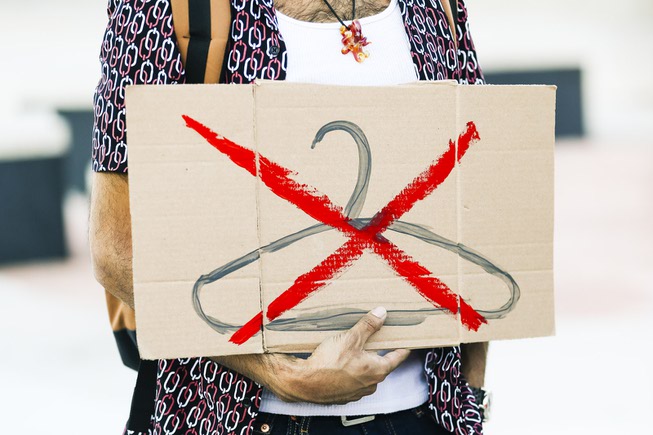
An abortion-rights demonstrator protests the U.S. Supreme Courts decision to overturn Roe v. Wade during a rally outside the Federal Courthouse in downtown Las Vegas Friday, June 24, 2022. WADE VANDERVORT
Saturday, June 24, 2023 | 2 a.m.
View more of the Sun's opinion section
It was one year ago today when the United States Supreme Court overturned 50 years of precedent and unleashed a powerful wave of suffering and uncertainty across the country by overturning Roe v. Wade and calling into question women’s rights to privately make decisions about their own health care.
In that time, Republican legislators in statehouses nationwide have made it abundantly clear that they have no interest in the rights or lives of women, the quality of health care in the United States or the perspectives of their constituents.
The Supreme Court’s decision in Dobbs v. Jackson Women’s Health Organization decision was, and continues to be, catastrophic for women, families and health care providers alike. Yet the full impact of the decision is largely unknown because draconian laws passed by GOP state legislators have made sharing data, information and stories about abortion access fraught with legal risks. Moreover, it’s impossible to know how many women have left the formal health care system in their home states entirely. Some might have the means to travel to states like Nevada, where women’s rights are protected; others tragically might seek “back-alley abortions” in settings and circumstances that fall far short of health and safety standards.
What we do know is that 66 health care facilities that provided abortions shut down in just the first 100 days after the decision. An additional 30 clinics cut staffing as they eliminated abortion services.
Almost all of the clinics were facilities that provided a variety of health care services to predominantly low-income women. Despite GOP rhetoric, they were not “abortion clinics,” they were “women’s health care clinics.” Which explains why the impact of the decision on women’s health care goes far beyond abortion services.
A survey conducted by the Kaiser Family Foundation found that 68% of obstetricians say the ruling has worsened their ability to manage pregnancy-related emergencies. In states where abortion is banned, half of obstetricians say their ability to practice within the standards of care has become worse. A majority of obstetricians also believe that the Dobbs decision and subsequent abortion bans have worsened pregnancy-related mortality, racial and ethnic inequities in maternal health and the ability to attract new doctors to the field.
Take note that according to the doctors in this survey, the Dobbs decision didn’t just make it more difficult for women to receive an abortion, the decision made it more difficult for women to receive quality reproductive health care. It made it more likely that women, especially Black and brown women, will needlessly die due to inflexible substandard health care.
The data is supported by real stories of real people affected by the decision.
These stories include the 10-year-old rape victim who was forced to travel out of state for an abortion. Her doctor has now been disciplined for sharing the story of a young girl who was violated twice, first by her rapist and then by a heartless legal system.
These stories also include women in the 24 states that banned abortion in the wake of the Dobbs decision, many of whom have suffered physical and emotional trauma because they were denied lifesaving health care or were forced to carry stillborn babies to term because the law denied them another option.
These are the real stories of our fellow Americans — family members, friends and neighbors — whose lives are at risk right now because they live in a society in which women’s bodies and women’s health care are not afforded the protection of privacy or autonomy rights.
This Supreme Court and GOP legislators have declared that simply because of their gender, women shall not have their rights protected in the same way that men’s rights are protected. A compelling argument can be made that corporations and firearms have more federal constitutional rights than women, who are subject to the personal religious beliefs of Supreme Court justices and Republican elected officials who are unaccountable to their voters.
Despite Justice Brett Kavanaugh’s claim in Dobbs that “difficult moral and policy questions will be decided, as the Constitution dictates, by the people and their elected representatives through the constitutional processes of democratic self-government,” evidence shows that the people have no power or voice in the abortion laws of their states. This runs counter to the court’s numerous rulings that fundamental civil rights are not to vary among the states and has been shown to be an unrealistic expectation in GOP-controlled state legislatures.
Nationally, 62% of Americans polled by Pew Research said abortion should be legal in all or most cases. Even in states like Ohio, Wisconsin, Missouri, Arkansas and North Dakota, a majority of voters support abortion rights in all or most cases. Yet every one of those states now has an abortion ban on the books because of radicals in the GOP.
In Wisconsin, GOP legislators didn’t even have the courage to affirmatively vote to ban abortions. Instead, they punted like cowards and allowed a 170-year-old law to govern the state while blocking all attempts by state’s residents to overturn it.
Adding insult to injury, the GOP-controlled legislatures of every one of those states also fought to silence voters and prevent them from placing initiatives on the ballot that would overturn abortion bans via a popular vote.
The American people, and women especially, deserve better.
Voters of all political stripes should demand better by asking each of their representatives to explain their position on voter initiatives and women’s health care and abortion rights. Those elected who refuse to answer or refuse to respect the will of the people can then be identified and voted out of office.
